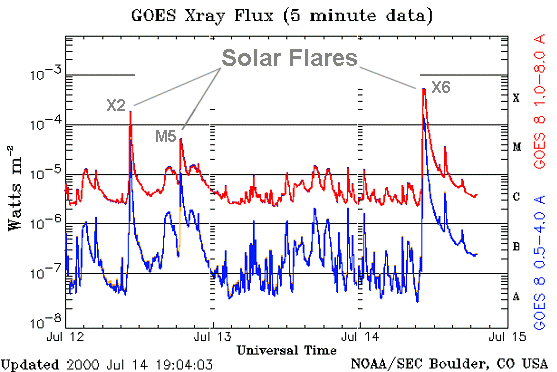Sonne live

National Oceanic and Atmospheric Administration

Bestätigung der eigenen Aufzeichung mit NOAA
Die NOAA - Sonde zeigt eine LIVE - Aufzeichnung 24h. Mit dem Equipement "Radioastronomie Primefokus - Spiegel" sollte man X - bzw. M - Flares messen können.
Zur Bestätigung, wenn man bei der Aufzeichung ein Peak erhält, kann man mit dieser Graphik chronologisch nachvollziehen, daß es keine Störstrahlung ist, sondern wirklich ein registrierter Flare
der Sonne.
Messbare Flares (X,M) mit Radioteleskop und umgebautem Satfinder.
Eine Sonneneruption ist ein Gebilde erhöhter Strahlung innerhalb der Chromosphäre der Sonne, das durch Magnetfeldenergie gespeist wird.
- Als Flare oder chromosphärische Eruption bezeichnet man einfache Plasma-Magnetfeldbögen.
- Kommt es zu einer Reorganisation der Bögen, die zu einer Ablösung von Plasmaschläuchen führt, so beobachtet man einen erhöhten Masseausstoß. Bezeichnungen dafür sind Koronaler Massenauswurf (CME) oder auch Eruptive Protuberanz, die damit verbundenen Teilchenstürme Sonnensturm, Protonenschauer, Solarkosmischer Strahlungsausbruch (englisch Solar Cosmic Ray Event) oder SEP (englisch Solar Energetic Particles). Die Teilchen eines koronalen Masseauswurfs wechselwirken mit dem Sonnenwind und dem interplanetaren Magnetfeld: schnelle Teilchen werden auf die Geschwindigkeit des Sonnenwinds abgebremst, langsame beschleunigt. Es kommt zur Ausbildung einer breiten Schockfront, die für die Beschleunigung der Teilchen, insbesondere Protonen, auf Energien oberhalb von 10 MeV verantwortlich ist. Der Prozess der Beschleunigung heißt SPE (englisch Solar Particle Event, auch Solar Proton Event).
(Text:Wikipedia)
The Classification of X-ray Solar Flares
or "Solar Flare Alphabet Soup"
A solar flare is an explosion on the Sun that happens when energy stored in twisted magnetic fields (usually above sunspots) is suddenly released. Flares produce a burst of radiation across the electromagnetic spectrum, from radio waves to x-rays and gamma-rays. [more information]
Scientists classify solar flares according to their x-ray brightness in the wavelength range 1 to 8 Angstroms. There are 3 categories: X-class flares are big; they are major events that can trigger planet-wide radio blackouts and long-lasting radiation storms. M-class flares are medium-sized; they can cause brief radio blackouts that affect Earth's polar regions. Minor radiation storms sometimes follow an M-class flare. Compared to X- and M-class events, C-class flares are small with few noticeable consequences here on Earth.
This figure shows a series of solar flares detected by NOAA satellites in July 2000:

Each category for x-ray flares has nine subdivisions ranging from, e.g., C1 to C9, M1 to M9, and X1 to X9. In this figure, the three indicated flares registered (from left to right) X2, M5, and X6. The X6 flare triggered a radiation storm around Earth nicknamed the Bastille Day event.
| Class |
Peak (W/m2)between 1 and 8 Angstroms |
|
|
I < 10-6 |
|
|
10-6 < = I < 10-5 |
|
|
10-5 < = I < 10-4 |
|
|
I > = 10-4 |
(Daten aus
http://spaceweather.com)
|
|







.jpg)

